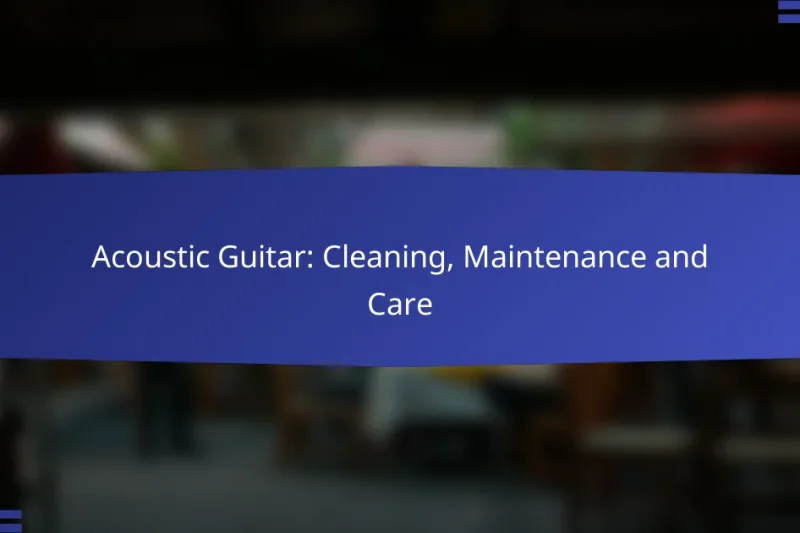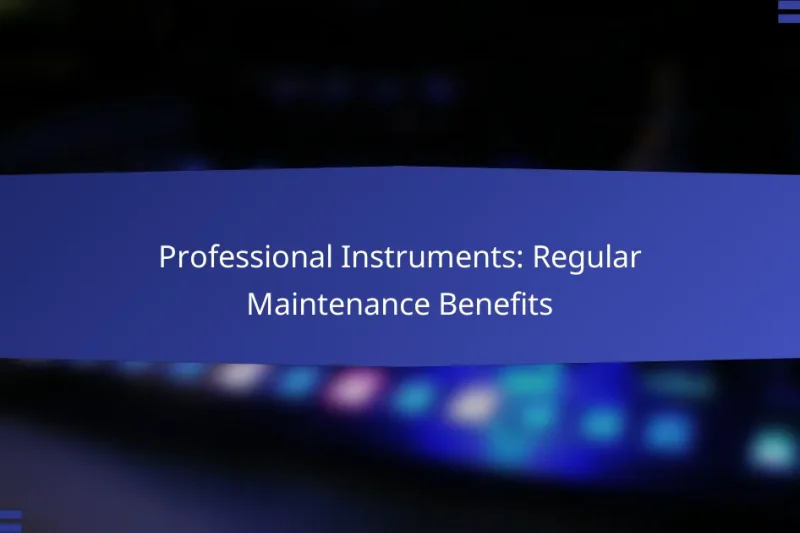Proper cleaning, maintenance, and care of an acoustic guitar are essential for preserving its appearance and … Acoustic Guitar: Cleaning, Maintenance and CareRead more
Instrument Maintenance and Care
Proper instrument maintenance and care are essential for ensuring optimal performance and longevity. Regular cleaning, humidity control, and timely replacements are key practices that help preserve your musical instruments. Utilizing specialized products and tools can further enhance their condition, while troubleshooting common issues can prevent potential problems from escalating.
Professional Instruments: Regular Maintenance Benefits
Regular maintenance for professional instruments is crucial for maximizing their performance and lifespan. By implementing a … Professional Instruments: Regular Maintenance BenefitsRead more
How to maintain musical instruments effectively?
Maintaining musical instruments effectively involves regular cleaning, humidity control, timely string replacements, and professional servicing. These practices help ensure optimal performance and longevity of the instrument.
Regular cleaning techniques
Regular cleaning is essential for maintaining the sound quality and appearance of musical instruments. For string instruments, use a soft cloth to wipe down the body and strings after each use to remove oils and dirt. Woodwind instruments may require swabs or brushes to clean the interior and pads.
For brass instruments, a mixture of warm water and mild soap can be used for cleaning the exterior, while a snake brush is effective for the tubing. Always ensure that any cleaning solution is safe for the specific material of your instrument.
Humidity control methods
Humidity control is crucial for preserving wooden instruments, as excessive moisture can lead to warping or cracking. Aim to keep the humidity level between 40% and 60% using a hygrometer. Consider using a dehumidifier in damp environments or a humidifier in dry conditions.
Instrument cases with built-in humidity control features, such as humidipaks, can help maintain stable moisture levels. Regularly check the humidity levels inside the case to ensure your instrument remains protected.
String replacement schedules
String replacement schedules depend on the type of instrument and frequency of use. For guitars, changing strings every 1-4 weeks is common, while violins may require strings to be replaced every few months, depending on play intensity.
Signs that strings need replacement include dull sound, visible wear, or difficulty in tuning. Keeping a log of when strings were last changed can help establish a consistent replacement routine.
Professional servicing recommendations
Professional servicing is recommended at least once a year for most instruments, especially for those that are played regularly. Technicians can perform detailed inspections, adjustments, and repairs that are difficult to do at home.
For woodwinds and brass, regular servicing can include pad replacement and valve adjustments, while string instruments may need bridge adjustments or soundpost repositioning. Always consult with a qualified technician familiar with your specific instrument type for the best care practices.
What are the best products for instrument care?
The best products for instrument care include specialized cleaning solutions, high-quality polishing cloths, and essential maintenance tools. Selecting the right products ensures your instruments remain in optimal condition, enhancing their longevity and performance.
Top-rated cleaning solutions
Effective cleaning solutions are crucial for maintaining the integrity of your instruments. Look for products specifically designed for your instrument type, such as alcohol-based cleaners for brass or gentle soap solutions for woodwinds. Avoid harsh chemicals that could damage finishes or components.
Some popular options include microfiber cloths paired with distilled water for light cleaning, or dedicated instrument cleaners that are pH balanced. Always follow the manufacturer’s recommendations for cleaning frequency and methods.
Recommended polishing cloths
Polishing cloths are essential for removing fingerprints and smudges while preventing scratches. Choose soft, lint-free cloths made from materials like microfiber or cotton. These materials are gentle and effective for polishing without causing damage.
For best results, use a separate cloth for cleaning and polishing. Regularly wash or replace your cloths to avoid transferring dirt back onto your instruments.
Essential maintenance tools
Having the right maintenance tools is vital for keeping your instruments in top shape. Essential tools may include screwdrivers, lubricants, and cleaning brushes tailored to your specific instrument. Regular maintenance can help prevent costly repairs down the line.
Consider investing in a maintenance kit that includes all necessary tools. Familiarize yourself with basic maintenance tasks, such as oiling valves or adjusting screws, to ensure your instrument performs optimally.
How to troubleshoot common instrument issues?
Troubleshooting common instrument issues involves identifying the problem, assessing its impact, and applying appropriate fixes. Regular maintenance and careful observation can help prevent many issues from arising.
Identifying tuning problems
Tuning problems often manifest as off-pitch sounds or difficulty in achieving the desired tone. To identify these issues, listen for inconsistencies in pitch during play and use a tuner to check accuracy. Regularly tuning your instrument before use can help catch these problems early.
Common causes of tuning issues include temperature changes, humidity, and worn strings. Maintaining a stable environment for your instrument can mitigate these factors.
Fixing minor repairs
Minor repairs can often be handled at home with basic tools. For instance, replacing a broken string or tightening loose screws can restore functionality. Familiarize yourself with your instrument’s manual for specific repair instructions.
When performing repairs, always use the correct materials to avoid further damage. If unsure, consult a professional to prevent costly mistakes.
Addressing sound quality issues
Sound quality issues can arise from various factors, including dirty components, improper setup, or damaged parts. Start by cleaning your instrument thoroughly, focusing on areas like the mouthpiece or sound holes, which can accumulate debris.
If sound quality remains poor, check for any physical damage or misalignments. Adjusting the setup or replacing worn components can significantly improve performance. Regular maintenance checks can help catch these issues before they affect sound quality.
What are the guidelines for storing instruments?
Proper storage of instruments is essential to maintain their functionality and longevity. Key guidelines include controlling environmental factors, using protective cases, and following best practices for long-term storage.
Optimal storage conditions
Instruments should be stored in a clean, dry environment with stable temperature and humidity levels. Ideally, temperatures should range between 20°C to 25°C (68°F to 77°F) with humidity below 50%. Fluctuations can lead to corrosion or damage.
Ensure that the storage area is free from dust and contaminants, as these can affect the performance of the instruments. Regularly check the conditions to maintain optimal storage standards.
Protective cases and covers
Using protective cases and covers is crucial for safeguarding instruments against physical damage and environmental factors. Choose cases that are specifically designed for your instruments, ensuring a snug fit to prevent movement during storage.
Consider materials that offer shock absorption and moisture resistance. For example, hard-shell cases provide excellent protection, while padded covers can be useful for delicate instruments.
Long-term storage tips
For long-term storage, clean instruments thoroughly before placing them in storage to prevent corrosion. Use appropriate cleaning solutions and follow the manufacturer’s guidelines to avoid damaging finishes.
Store instruments in their cases or covers, and avoid stacking them to prevent pressure points. Regularly inspect stored instruments for signs of wear or damage, and re-evaluate storage conditions periodically to ensure they remain suitable.
What are the differences in care for various instruments?
Different musical instruments require unique care techniques to maintain their sound quality and longevity. Understanding these differences is essential for musicians to ensure their instruments perform optimally.
Care for string instruments
String instruments, such as violins and cellos, require regular cleaning and maintenance to prevent damage. Wiping down the strings and body after each use helps remove rosin build-up and moisture, which can affect sound quality.
Additionally, it’s important to check the tension of the strings regularly and replace them as needed. Humidity control is crucial; ideally, string instruments should be kept in an environment with humidity levels between 40% and 60% to prevent warping or cracking.
Care for woodwind instruments
Woodwind instruments, including flutes and clarinets, need careful attention to their pads and keys. Regularly swabbing the inside with a cleaning cloth after playing helps remove moisture and prevents pad deterioration.
Inspecting the pads for wear and ensuring the keys are functioning smoothly is vital. Avoid exposing woodwind instruments to extreme temperatures or humidity, as these can warp the wood and affect playability. Regular professional servicing is recommended every year or two to maintain optimal performance.

